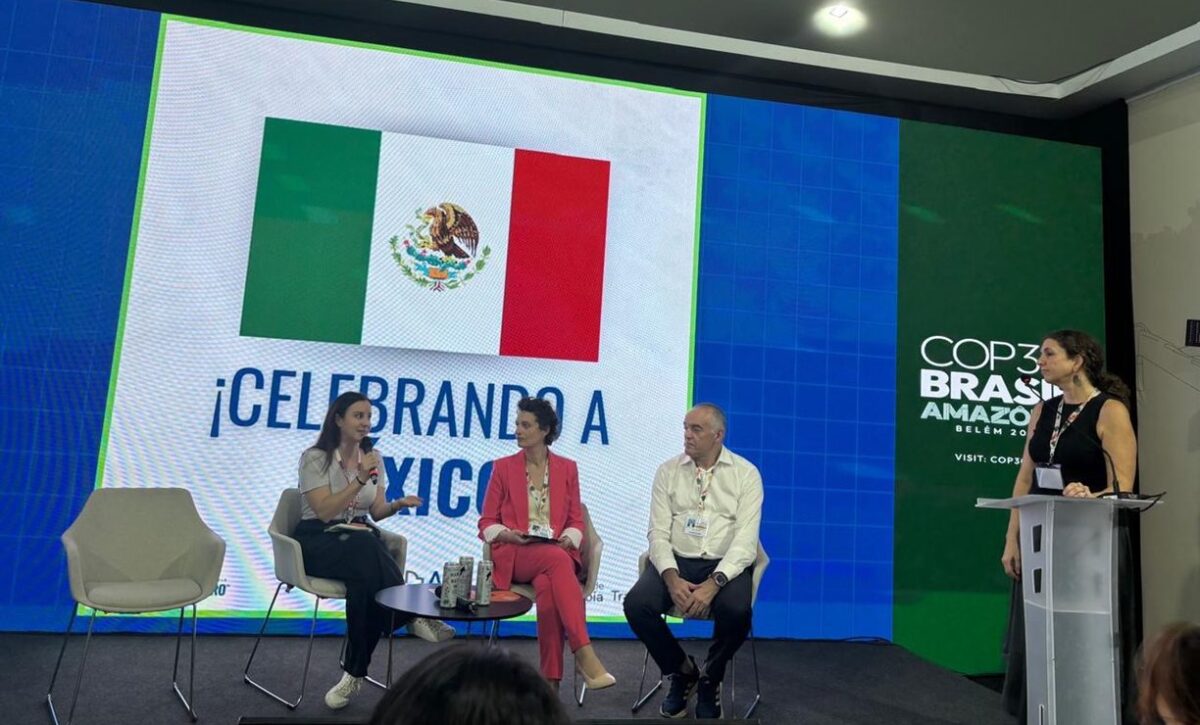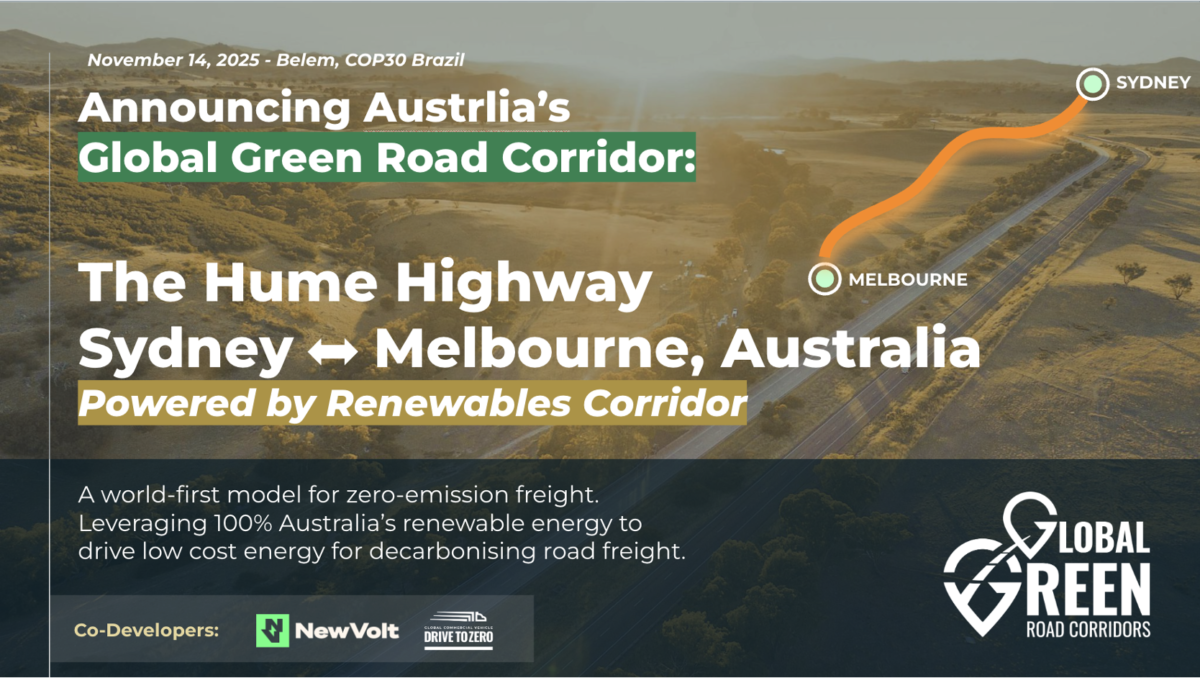Program Updates
At COP30, Drive to Zero and our Global MOU signatories, endorsers and partners demonstrated a deep commitment to the global effort to drive down carbon emissions in transport and safeguard our planet for future generations. Indeed, our community’s momentum is growing. Mexico—the largest exporter of tractor trailers and 13th largest economy in the world—has signed the Global MOU. This year alone, the Global MOU has welcomed 60 new signatories and endorsers encompassing national governments, sub-national governments, private sector innovators, and non-governmental organizations (NGOs).

On November 11, Drive to Zero co-hosted “Roadmap to Zero: Accelerate. Adopt. Deploy.” at COP30.
At the start of the year, Global MOU signatory countries stood at 38 total. Today, Global MOU countries represent 21% of trucks and buses globally and —with the additions of Mexico, Peru, and Montenegro—now account for nearly 42% of the world’s GDP.

Stephanie Kodish highlights the Global MOU community’s rapid growth.
Beyond these signatory commitments, the Global MOU community is taking intentional and ambitious action to achieve the Global MOU goals. The drive to achieve 30% new zero-emission truck and bus sales by 2030, and 100% by 2040 is within reach. In every corner of the world, we’re seeing key steps being taken across the three areas critical to fuel this transition: policy, finance, and infrastructure.
- Ethiopia’s ban on internal combustion engine imports is delivering at scale, with their total EV fleet growing from 20,000 in 2023 to 115,000 by mid 2025.
- The Small Industries Development Bank of India (SIDBI) is setting up DRISHTI, a risk-sharing facility that will expand access to loans to small owner operators to purchase electric trucks.
- In Brazil, the public-private e-Dutra coalition is transforming the Rio de Janeiro–São Paulo freight transportation corridor into the country’s first zero-emission highway.
- Australia is getting its first electric truck corridor, which will be the first GGRC fully powered by renewables. At COP, Drive to Zero and NewVolt jointly announced the Sydney–Melbourne Powered by Renewables Corridor, which will span 880 km along the Hume Highway and cut 200,000 tonnes of CO₂ annually by 2030.

At COP30, Mexico becomes the 41st country to sign the Global MOU.
For Drive to Zero, this year’s COP represented a full circle moment. We launched the Global MOU in 2021, at COP26 in Glasgow. In just four short years, our community has become a model for effective international cooperation on transport decarbonization. The world is not only watching but depending on our success—let’s continue to show what’s possible.
Drive to Zero is thankful for all of you and your commitment to creating a cleaner, more resilient, just, and more modern transportation system that will benefit all people.
— Stephanie Kodish, Global Director, CALSTART/Drive to Zero
Special Features
GGRC at COP30: Brazil Announces Latin America’s First Global Green Road Corridor
At COP30, Drive to Zero and partners announced the e-Dutra Coalition, a public–private partnership dedicated to transforming freight transport along Brazil’s Rio de Janeiro–São Paulo corridor into the country’s first zero-emission highway. Bringing together leading companies, infrastructure providers, and government partners, the coalition aims to deploy 1,000 electric trucks and a network of high-capacity chargers by 2030. As part of the Laneshift Initiative and the Global Green Road Corridors program, e-Dutra advances Brazil’s leadership in sustainable mobility, improving air quality, reducing carbon emissions, and creating new opportunities for green economic growth.
Read more about that announcement here.

Announcing the new Brazil e-Dutra Coalition Corridor at COP30.
GGRC: Announcing Australia’s Electric Truck Corridor Powered by Renewables

Also announced at COP30: Australia’s plans for a Global Green Road Corridor powered by renewable energy.
Together with our partner NewVolt, Drive to Zero is spotlighting the Sydney–Melbourne Powered by Renewables Corridor, Australia’s first electric truck corridor under the Global Green Road Corridors (GGRC) initiative.
Spanning 880 km along the Hume Highway, this flagship project will demonstrate the operational and financial viability of zero-emission trucking along Australia’s busiest freight route with the ambition of reducing 200,000 tonnes of CO₂ annually by 2030 and showcasing renewable-powered logistics at scale.
🌏 The Coalition will launch at COP31 (2026) and will position Australia as a regional leader in clean, electrified freight.
In the Spotlight: Celebrating Global MOU Co-Lead Colombia

Photo from Transport Toward COP30: Sustainability in Motion in Bogota, Colombia. From Left to Right: Colombia Transport Minister Advisor Gina Paola Castro Jessen, Colombia Transport Minister María Fernanda Rojas Mantilla, Senior Global Director of CALSTART/Drive to Zero Stephanie Kodish, Europe Director of CALSTART/Drive to Zero Sita Holstag.
In October, Colombia hosted a high-level event in Bogota for Latin American transportation ministers called “Transport Toward COP30: Sustainability in Motion.” Drive to Zero’s Global Senior Director Stephanie Kodish took this unique opportunity to highlight Colombia’s longstanding commitment to the Global MOU community, and her excitement to be working with the country’s new Transportation Minister María Fernanda Rojas Mantilla, who took office in January. Colombia signed the Global MOU at COP28 in Dubai and became co-lead at ITF in Germany last Spring. Colombia’s transition to ZE-MHDVs is expected to deliver $32M in economic benefits by 2050, along with strengthened energy security, plentiful new jobs, cleaner air, and a more sustainable climate that benefits us all.
Welcome our amazing new Global MOU Endorsers!
|
|
|
 |
|
|
|
|
|
Resources
New Resource: Our Global MOU Roadmap to 2040
As we approach the end of the year, Drive to Zero has launched a comprehensive digital experience, “Powering Forward: The Global Zero-Emission Transition,” that assesses the state of the global transition to 100% new zero-emission truck and bus sales by 2040. Designed to serve as an invaluable resource for Global MOU signatories and endorsers, partners, funders, and policymakers, Powering Forward documents how the Global MOU community is driving progress, presents the latest ZE-MHDV data, and identifies how to overcome key policy, financial, and infrastructure challenges. Powering Forward is your one-stop-shop for how we achieve the Global MOU goals—our roadmap to powering a zero-emission transportation future.
COP30: Drive to Zero Partner Utilities for Net Zero Alliance Announces Major Energy Transition Investment

UNEZA announces major energy transition investment at COP30. Photo credit: UNEZA.
At COP30, Utilities for Net Zero Alliance (UNEZA)—a key partner of CALSTART and Drive to Zero – announced its members’ collective commitment to invest $148 billion (USD) per year in renewables, grids, and storage. This commitment will bring their total contribution to the energy transition to around $1 trillion by 2030 and support their stated goal to triple renewable capacity, strengthen grids, and advance energy storage. These advancements are essential for the transport sector, which depends on reliable, flexible and clean power systems to enable a broad shift toward zero-emission transport.
Drive to Zero celebrates this increased ambition, recognizing it as an important contribution to the conditions that will enable zero-emission transport to grow.
Top Headlines

Market
- New commercial vehicle registrations: vans -8.2%, trucks -9.8%, buses +3.6% in Q1-Q3 2025
- Truckmakers ask EU for looser emissions targets, letter shows
Fleet Deployments
- Rohrdorfer Zement introduces three electric trucks for Gmunden plant
- Tesco orders 750 Maxus eDeliver 9
- Toll announces next phase of its $67 million electric vehicles program with Coca-Cola Europacific Partners
- Meet the electric vehicles delivering Amazon packages in the UK
- HIVED announces expansion to eight new cities
- IVECO BUS wins Acamir tender: 87 eDAILY minibuses to modernise school transport in Campania, Italy
- 100 electric buses for South Africa! MAN Truck & Bus receives largest eBus order outside Europe
- Harbinger lands $160M Series C, inks initial FedEx deal for 53 electric trucks
Manufacturers and Models: Trucks and Buses
- Daimler Truck, HHLA and Kawasaki Heavy Industries launch strategic partnership to establish liquid hydrogen supply chain for Europe
- Thomas Built Buses introduces Wattson, the company’s first electric Type D school bus
Financial Incentives
- 80 million euros e-bus fund launched in Brazil, aiming to introduce more than 1,700 vehicles by 2030
- TRATON GROUP launches Green Finance Framework to finance and refinance battery-electric commercial vehicles
Fuels and Infrastructure







